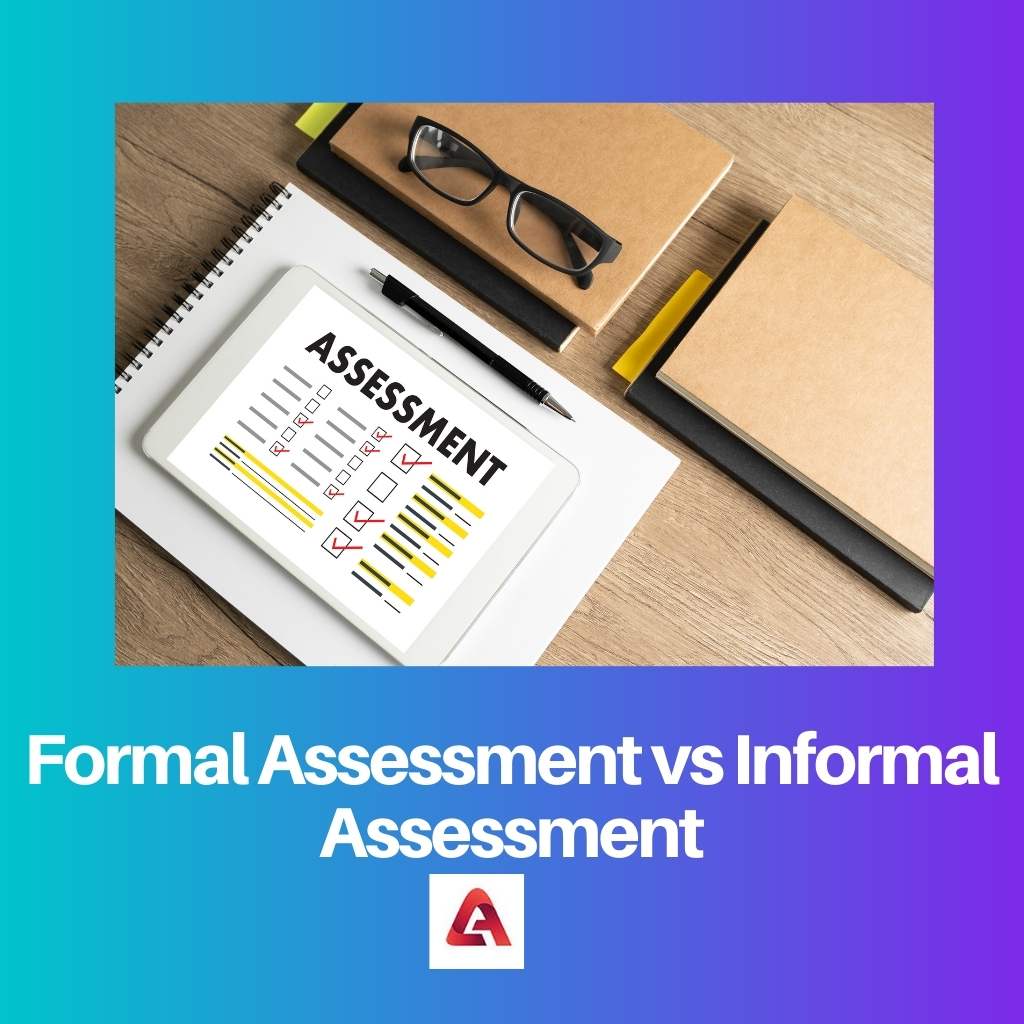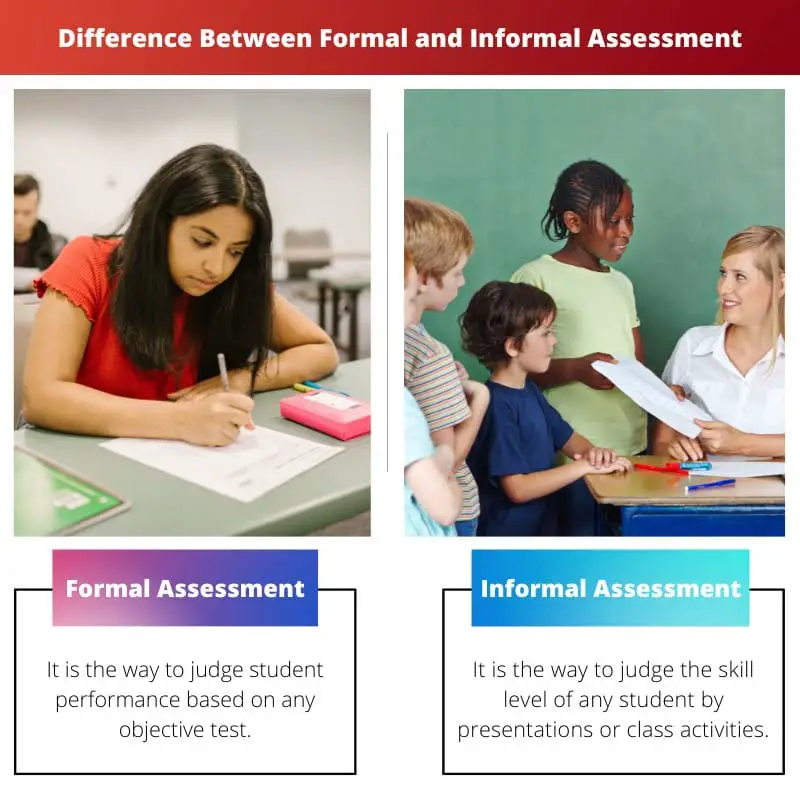Assessments are an important part of any educational job. It helps all the teachers to assess their students so that they can make correct decisions about grasping the students. Assessment has been classified into two categories, the first one is formal assessment and the other is informal assessment. Here is the detailed difference between formal and informal assessments.
Key Takeaways
- Formal assessments use standardized tests and tools to measure a learner’s progress, while informal assessments rely on observation and less structured methods.
- Formal assessments produce quantitative data and allow for comparison, while informal assessments provide qualitative data and individualized feedback.
- Formal assessments can cause test anxiety and may not capture a learner’s full potential, while informal assessments offer a more relaxed and comprehensive view of a learner’s abilities.
Formal Assessment vs Informal Assessment
Informal assessments are unorganized evaluations of students. It can be a random in-class question-answer session, oral topic presentation, or lecture summary. In formal assessments, students’ skills are assessed according to specific criteria. It includes quizzes, papers, assignments, etc.

A formal assessment is a way to check out each student’s performance objectively. It helps the teachers know how much a student has learned during instruction. This type of assessment is announced when the topic ends, and then the questions are asked in this type of assessment that is related to the topic.
Informal assessments are those forms of assessments that help the teachers to measure the student’s performance through presentations and different activities in the class. It also helps to judge the student’s skill level. To assess students’ skills, you can ask some questions they are required to answer in front of the whole class.
Comparison Table
| Parameters of Comparison | Formal Assessment | Informal Assessment |
|---|---|---|
| Definition | It is the way to judge student performance based on any objective test. | It is the way to judge the skill level of any student through presentations or class activities. |
| Example | Standardized tests | Observations |
| Testing way | Test and quizzes | By observing students in between the lecture by stopping it |
| Criteria | Criteria to evaluate the performance of students | No criteria to evaluate the performance of students |
| Purpose | It is used to access the student’s knowledge at the end of a lecture. | It is used to check the learner’s skill level and progress. |
What is Formal Assessment?
A formal assessment is a method used to check a student’s knowledge level by giving them a score on an objective type test. It is the way to find out what the student has learned during his lecture or instruction period. Tests and quizzes are the most common examples of formal assessment.
Teachers use formal assessments when they want to know the knowledge criteria of their students. Formal grading methods in tests help teachers know about their students’ performance. Due to formal assessment, students pay more attention during their lectures and attend them carefully.
Formal assessments help students to get higher marks by performing well in class. Through formal assessment, students move to the next step of the learning phase. A formal assessment provides an overview of any student’s knowledge. Some various purposes of formal assessments are as follows:
- It helps the teacher to understand the learning gaps between students and lets them know which topic needs to be explained more.
- The formal assessment also helps the teacher recognise students’ strengths and weaknesses compared to other students.
- It also helps them know about the amount of knowledge students gain from the topic.

What is Informal Assessment?
Informal assessments are used to judge students’ individual performance through any presentation or class activities. It helps to measure the student’s progress without any grading criteria. The best examples of informal assessments are the presentations that are given by students in the class or on any other occasion.
Project-based assignments and presentations are examples of informal assessments. It helps to boost the confidence of all the students. Tests, quizzes, grading, and writing samples are all types of informal assessments. During an informal assessment, teachers never give grades to their students to check their progress level, but they only check out the performance of students during the presentation.
The purpose of informal assessment is to check the learners’ progress and identify the difficulties and challenges that they may face. Some various purposes of informal assessment are as follows:
- Informal assessment is a way to evaluate the practical skills of the students.
- Projects and presentations are given to students for performing the informal assessment.
- In the informal assessment, no criteria are decided to evaluate the performance of students by a presentation.

Main Differences Between Formal and Informal Assessment
- Formal assessments are used to determine the performance of students by taking tests on the previous topic, while informal assessment is determined by the presentation skill level in the class.
- Quizzes and tests are taken during formal assessments, while presentations and assignments are taken during informal assessments.
- Formal assessment always has standard criteria for evaluating students’ performance, while informal assessment has no specific criteria for evaluating performance.
- Formal assessments are used to know about the knowledge that the students gained during lectures. On the other hand, informal assessments are used to check out learners’ skill levels.
- Formal assessments always have standardized tests, while informal assessments are based on observations.

- https://journals.sagepub.com/doi/abs/10.1177/107179190000700307
- https://books.google.co.in/books?hl=en&lr=&id=2J_OCwAAQBAJ&oi=fnd&pg=PA81&dq=Difference+Between+Formal+and+Informal+Assessment+&ots=RkjXvUHx57&sig=e59uQXtkqNz0sS9DAJ6Vl1ePvqw

This article simplifies the complexities of formal and informal assessments, making it accessible to a wider audience. Highly beneficial and enlightening.
The detailed comparison between formal and informal assessments is commendable. It contributes significantly to understanding these evaluation methods more effectively.
I concur. The article provides a clear and insightful comparison, offering valuable knowledge to educators and individuals interested in the field of assessment.
Indeed, the clarity and depth of the comparative analysis regarding formal and informal assessments are praiseworthy. Well-articulated and informative.
The in-depth comparison of formal and informal assessments provides a clear understanding of both evaluation methods used in education.
Absolutely, the article delineates the distinctions between formal and informal assessments, which is beneficial for educators and students.
A well-written essay that provides a comprehensive analysis of the different types of assessments.
Informative and constructive analysis of different types of assessments, I feel more enlightened after reading it. Thanks for sharing!
Yes, the author does an excellent job of explaining the differences between formal and informal assessments and their purpose.
The explanations provided for formal and informal assessments are compelling and educational. This article offers valuable insight into assessment practices.
While the article effectively discusses formal and informal assessments, the absence of practical examples illustrating these concepts limits its efficacy.
I echo your sentiment. Incorporating practical instances would have enriched the analysis and application of formal and informal assessments.
That’s a valid observation. Practical examples would have enhanced the article’s usefulness, providing a more tangible understanding for readers.
The comprehensive explanation detailing both formal and informal assessments gives a better understanding of their differences and applications.
I agree. The comparisons drawn between formal and informal assessments are enlightening and provide valuable insights into their role in the educational sphere.
It is evident that the author has done meticulous research to present a comprehensive discourse on formal and informal assessments. Highly informative.
While the article explains the differences between formal and informal assessments, I believe it is too verbose and could have been more concise in its approach about the topic.
That’s a valid point. I think a more succinct article would have been more effective in conveying the information to the readers.